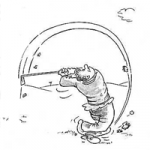 PEACE OF MIND and THE SECOND GOLFER
PEACE OF MIND and THE SECOND GOLFER
.
.Okay, we have all done it; hit a less than satisfying shot only to drop another ball and hit it perfect. Most commonly done while putting. Miss the first putt then pull it back and drain the next one.
I have played golf with thousands of people and have observed this phenomenon over and over again. I have watched golfers try so hard to hit a good shot, only to be disappointed with the result, then drop a second ball and hit the shot the way they intended, with ease and calmness, only to be more disappointed. They will ask me, “Why”? They say, “If I could only play like that second golfer I could beat anyone”.
What I observe is that each golfer who “tries” so hard the first time, with poor results, then relaxes and makes their true swing. This swing is free of tension and free of the effort to control the result. The second golfer no longer fears the result, this golfer is not trying to hit the ball perfect, not trying to do everything perfect to achieve the result but instead, the second golfer is “free” to swing. Not expecting a result but observing what happens.
I believe that golf should be played with the “second golfer” mind. I know that, from my own experiences. When I “try” to control the result by doing everything perfect, I fail to perform. Because of this, I am more frustrated causing me to lose confidence in my swing. I have learned and want to teach you all, a more enjoyable way to play golf. I have changed my mentality over shots so that I spend time preparing for a result. I do this by analyzing the lie of the ball, the conditions of the shot and the playing yardage. The playing yardage is not what is on the sprinkler head or the GPS device but what the conditions warrant. Is the shot uphill? Is the wind helping or hurting? Is the flag front, back or middle? After feeding my analytical mind with this information I choose a club and let the performance mind take over. This is accomplished by getting into my routine and believing that I have made the right choice, allowing me to perform the best swing I can, at that time, without expectations toward the result. What I have found, with this state of mind, is that the good shots come more frequently and I am continually surprised by the outcome. Also, I am not so frustrated because I was not focused on trying to hit the ball perfect, therefore when the shot is off, it does not bother me as much. The bad shot is just part of the game and where I am at that point in time. I can let it go and get ready for the next shot more easily.
The joy of hitting a good shot, when not “trying” to, far out weighs the disappointment that comes from trying to hit it perfect and not doing so. By changing from the analytical golf swing to the performance golf swing, I have found that my confidence stays high and I can deal with the misses more easily.
If you can keep your confidence up and frustration down you will find golf far more enjoyable.
One thing is for certain, confidence is contagious while frustration increases tension and tension is a toxin to the golf swing.
Good Golfing and learn to golf your way!
JB
Enjoyed this post. Share It:


